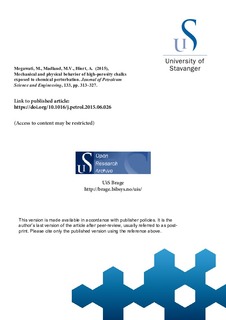| dc.contributor.author | Megawati, Megawati | |
| dc.contributor.author | Madland, Merete Vadla | |
| dc.contributor.author | Hiort, Aksel | |
| dc.date.accessioned | 2017-09-14T11:32:43Z | |
| dc.date.available | 2017-09-14T11:32:43Z | |
| dc.date.issued | 2015-09 | |
| dc.identifier.citation | Megawati, M., Madland, M.V., Hiort, A. (2015), Mechanical and physical behavior of high-porosity chalks exposed to chemical perturbation. Journal of Petroleum Science and Engineering, 133, p. 313-327 | nb_NO |
| dc.identifier.uri | http://hdl.handle.net/11250/2454693 | |
| dc.description.abstract | Extensive study on the effect of dissolution–precipitation on mechanical behavior of various high-porosity outcrop chalks (Liége, Aalborg, Kansas, Stevns Klint, and Mons) flooded with simplified aqueous chemistry at 130 °C under isotropic stress beyond the yield is performed. Chemical effects induced by injection of 0.219 M MgCl2 solutions into impure chalks (Liége, Aalborg, Kansas) lead to an immediate enhancement on the macroscopic creep with more than a factor of 2 larger than that of exposed to 0.657 M NaCl solutions. In pure chalks (Stevns Klint and Mons) however, the creep response is characterized by a time lag, where creep initially diminishes before a tertiary-like creep develops. Systematic correlation between calcite dissolution and the resulting creep strain is consistently demonstrated by all the different chalk types.
The chemical effects are described as precipitation of Mg-bearing minerals and dissolution processes, which involve both the carbonate and non-carbonate phases. SEM-EDS, XRD, and BET (N2) analyses indicate newly formed Mg-bearing minerals primarily present as Magnesite, which precipitated in the pore space. Enhanced dissolution is shown by continuous production of Ca2+ measured in the core effluent. The time for the dissolution to overcome intergranular friction accounts for the delay in the creep acceleration in pure chalks (Stevns Klint and Mons). For impure chalks (Liége, Aalborg, Kansas) chemical alterations on the non-carbonate phases outweigh the intergranular friction. This additional effect accounts for the immediate impact in the creep deformation.
The chemical effects are also demonstrated by marked reduction in the permeability. The porosity–permeability relationship measured at the end of creep test is shifted down from the initial correlation, indicating a dramatic increase in the chalk specific surface area. | nb_NO |
| dc.language.iso | eng | nb_NO |
| dc.publisher | Elsevier | nb_NO |
| dc.rights | Attribution-NonCommercial-NoDerivatives 4.0 Internasjonal | * |
| dc.rights.uri | http://creativecommons.org/licenses/by-nc-nd/4.0/deed.no | * |
| dc.subject | chalk | nb_NO |
| dc.subject | rock mechanics | nb_NO |
| dc.subject | chemical effect | nb_NO |
| dc.subject | dissolution | nb_NO |
| dc.subject | precipitation | nb_NO |
| dc.subject | creep | nb_NO |
| dc.subject | compaction | nb_NO |
| dc.subject | water-weakening | nb_NO |
| dc.subject | porosity | nb_NO |
| dc.subject | permeability | nb_NO |
| dc.subject | petroleumsteknologi | nb_NO |
| dc.title | Mechanical and physical behavior of high-porosity chalks exposed to chemical perturbation | nb_NO |
| dc.type | Journal article | nb_NO |
| dc.type | Peer reviewed | nb_NO |
| dc.description.version | acceptedVersion | nb_NO |
| dc.rights.holder | © 2015 Elsevier B.V. All rights reserved | nb_NO |
| dc.subject.nsi | VDP::Teknologi: 500::Berg‑ og petroleumsfag: 510::Petroleumsteknologi: 512 | nb_NO |
| dc.source.pagenumber | 313-327 | nb_NO |
| dc.source.volume | 133 | nb_NO |
| dc.source.journal | Journal of Petroleum Science and Engineering | nb_NO |
| dc.identifier.doi | 10.1016/j.petrol.2015.06.026 | |

